Science
League of Legends Named Most Challenging Game in New Assessment

A recent assessment by the video game asset marketplace Chicks Gold has ranked League of Legends as the most difficult video game, achieving a perfect difficulty score of 10 out of 10. This ranking is based on extensive data analysis from howlongtobeat.com, which evaluated completion times and player dropout rates across more than 7,500 games. Online multiplayer games dominated the list, highlighting the substantial commitment required to master these titles.
The study focused on various metrics, including the total hours needed to complete main storylines, side quests, and attaining 100% completion. It also considered the percentage of players who started but did not finish each game. For titles without traditional narratives, such as League of Legends and Dota 2, alternative criteria were employed, including the time needed to unlock all champions or achieve mastery at high levels of play.
Top 10 Hardest Video Games Revealed
The analysis identified the top ten hardest video games, all of which require significant time investments. Here are the results:
1. **League of Legends (2009)** – Difficulty Score: 10.00
– Completionist Hours: 3,224.91
– Percentage Retired: 34.6%
2. **Aura Kingdom (2014)** – Difficulty Score: 9.97
– Completionist Hours: 9,341.75
– Percentage Retired: 36.6%
3. **Dota 2 (2013)** – Difficulty Score: 9.89
– Completionist Hours: 2,285.63
– Percentage Retired: 36.8%
4. **Azur Lane (2018)** – Difficulty Score: 9.85
– Completionist Hours: 3,170.63
– Percentage Retired: 37.8%
5. **War Thunder (2012)** – Difficulty Score: 9.82
– Completionist Hours: 4,627.70
– Percentage Retired: 31.1%
6. **World of Warcraft (2004)** – Difficulty Score: 9.81
– Completionist Hours: 5,802.32
– Percentage Retired: 31.6%
7. **World of Tanks Blitz (2016)** – Difficulty Score: 9.78
– Completionist Hours: 3,500
– Percentage Retired: 23.0%
8. **Football Manager 2015 (2014)** – Difficulty Score: 9.69
– Completionist Hours: 902.53
– Percentage Retired: 38.4%
8. **Clicker Heroes (2015)** – Difficulty Score: 9.69
– Completionist Hours: 1,111.10
– Percentage Retired: 37.4%
8. **osu! (2007)** – Difficulty Score: 9.69
– Completionist Hours: 3,431.64
– Percentage Retired: 32.0%
9. **NGU Idle (2019)** – Difficulty Score: 9.68
– Completionist Hours: 4,548.76
– Percentage Retired: 15.0%
10. **Team Fortress 2 (2007)** – Difficulty Score: 9.60
– Completionist Hours: 2,880.56
– Percentage Retired: 31.5%
Insights into Player Commitment and Dropout Rates
The findings reveal that League of Legends not only requires an average of 1,144 hours for competitive play but also sees a significant 34.6% of players abandoning the game before reaching completion. In second place, Aura Kingdom demands an astonishing 9,341 hours for completionists, equivalent to over a year of continuous play, with a dropout rate of 36.6%.
Similarly, Dota 2 ranks third, with players needing approximately 850 hours for main objectives and 2,285 hours for full completion, alongside a retirement rate of 36.8%. The mobile naval warfare game Azur Lane has the highest dropout rate in the top ten at 37.8%, indicating that more than one in three players do not complete it.
The free-to-play game War Thunder holds the fifth position with a difficulty score of 9.82, requiring 4,627 hours for full mastery. In sixth place, World of Warcraft, a staple in the MMORPG genre, demands 5,802 hours for total completion, reflecting its enduring complexity since its launch in 2004.
These results underscore the immense dedication required by players to conquer these challenging games, while also highlighting the significant dropout rates that accompany such intense gaming experiences. The analysis from Chicks Gold serves as a valuable resource for gamers seeking to understand the commitment involved in mastering their favorite titles.
-

 Education3 months ago
Education3 months agoBrandon University’s Failed $5 Million Project Sparks Oversight Review
-

 Science4 months ago
Science4 months agoMicrosoft Confirms U.S. Law Overrules Canadian Data Sovereignty
-

 Lifestyle3 months ago
Lifestyle3 months agoWinnipeg Celebrates Culinary Creativity During Le Burger Week 2025
-

 Health4 months ago
Health4 months agoMontreal’s Groupe Marcelle Leads Canadian Cosmetic Industry Growth
-

 Technology3 months ago
Technology3 months agoDragon Ball: Sparking! Zero Launching on Switch and Switch 2 This November
-

 Science4 months ago
Science4 months agoTech Innovator Amandipp Singh Transforms Hiring for Disabled
-

 Education3 months ago
Education3 months agoRed River College Launches New Programs to Address Industry Needs
-

 Technology4 months ago
Technology4 months agoGoogle Pixel 10 Pro Fold Specs Unveiled Ahead of Launch
-

 Business3 months ago
Business3 months agoRocket Lab Reports Strong Q2 2025 Revenue Growth and Future Plans
-

 Technology2 months ago
Technology2 months agoDiscord Faces Serious Security Breach Affecting Millions
-

 Education3 months ago
Education3 months agoAlberta Teachers’ Strike: Potential Impacts on Students and Families
-

 Science3 months ago
Science3 months agoChina’s Wukong Spacesuit Sets New Standard for AI in Space
-

 Education3 months ago
Education3 months agoNew SĆIȺNEW̱ SṮEȽIṮḴEȽ Elementary Opens in Langford for 2025/2026 Year
-

 Business4 months ago
Business4 months agoNew Estimates Reveal ChatGPT-5 Energy Use Could Soar
-

 Technology4 months ago
Technology4 months agoWorld of Warcraft Players Buzz Over 19-Quest Bee Challenge
-

 Business3 months ago
Business3 months agoDawson City Residents Rally Around Buy Canadian Movement
-

 Technology2 months ago
Technology2 months agoHuawei MatePad 12X Redefines Tablet Experience for Professionals
-

 Business3 months ago
Business3 months agoBNA Brewing to Open New Bowling Alley in Downtown Penticton
-

 Technology4 months ago
Technology4 months agoFuture Entertainment Launches DDoD with Gameplay Trailer Showcase
-

 Technology4 months ago
Technology4 months agoGlobal Launch of Ragnarok M: Classic Set for September 3, 2025
-

 Technology4 months ago
Technology4 months agoInnovative 140W GaN Travel Adapter Combines Power and Convenience
-

 Science4 months ago
Science4 months agoXi Labs Innovates with New AI Operating System Set for 2025 Launch
-

 Top Stories2 months ago
Top Stories2 months agoBlue Jays Shift José Berríos to Bullpen Ahead of Playoffs
-

 Technology4 months ago
Technology4 months agoNew IDR01 Smart Ring Offers Advanced Sports Tracking for $169










